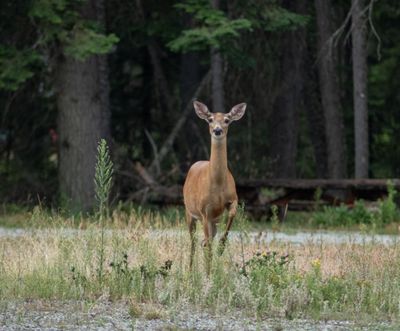Two more deer positive for CWD in North Idaho; prevalence low for now

Two more deer have tested positive for chronic wasting disease in the Idaho Panhandle, but wildlife officials are hopeful they’ve caught the outbreak in time to limit its spread.
The Idaho Department of Fish and Game announced this week that the two positive tests were part of a batch of 172 samples gathered through a special hunt and private land kills in Boundary County, where CWD was found for the first time in a white-tailed deer in August.
Carson Watkins, Idaho Fish and Game’s Panhandle region manager, said Wednesday that the agency has estimated the prevalence in the population at 1.2%. That’s below the agency’s target threshold of 2%, and the focus turns toward keeping it there.
“We don’t want to see it grow at all,” Watkins said.
This week, the agency announced new testing requirements and carcass transport restrictions for hunters in Boundary County east of the Selkirk Crest. Successful deer hunters will be required to get their animals tested for the always-fatal brain disease. The agency is also barring elk and deer hunters from hauling carcasses out of that area, instead requiring them to bone out the meat from the animals and leave behind the rest of the carcass.
It’s the third area of Idaho where those regulations have been ordered since 2021, when the state found its first case of CWD. Near White Bird, where prevalence is much higher, the state has ordered culls to cut population densities.
Watkins said the agency isn’t ready to make decisions like that in the Panhandle, and that officials will spend more time talking with locals and with the state Fish and Game Commission before moving forward.
“We don’t know where we’re headed yet,” he said.
CWD attacks the nervous systems of elk, moose and deer. It’s caused when proteins called prions become misfolded and cause other prions to misfold. As the disease progresses, it can cause animals to become emaciated and behave erratically before killing them.
Infected animals shed the prions through bodily fluids, which makes it easy for other animals to pick up the disease either through direct contact or by encountering infectious material in the wild.
In all, 35 states and five Canadian provinces have detected the disease in wild cervids. Washington found its first case in a deer in north Spokane this summer.
There’s no known risk to humans, but health officials advise against eating meat from infected animals. Left unchecked wildlife officials worry the disease could decimate populations.
Eradicating the disease is considered impossible, so wildlife managers try to limit the spread by tracking its prevalence in a given herd, discouraging the congregation of animals in large numbers and limiting the risk of humans moving infectious material into new places.
In the wake of its first detection, Washington ordered similar testing and carcass transport rules in its eastern region. It also prohibited wildlife feeding in the region.
Staci Lehman, a Washington Department of Fish and Wildlife spokesperson, said Tuesday that the agency had gathered 92 test samples from hunters this fall and that another 100 samples have been gathered from either roadkill or salvaged animals.
No additional animals have tested positive for CWD.